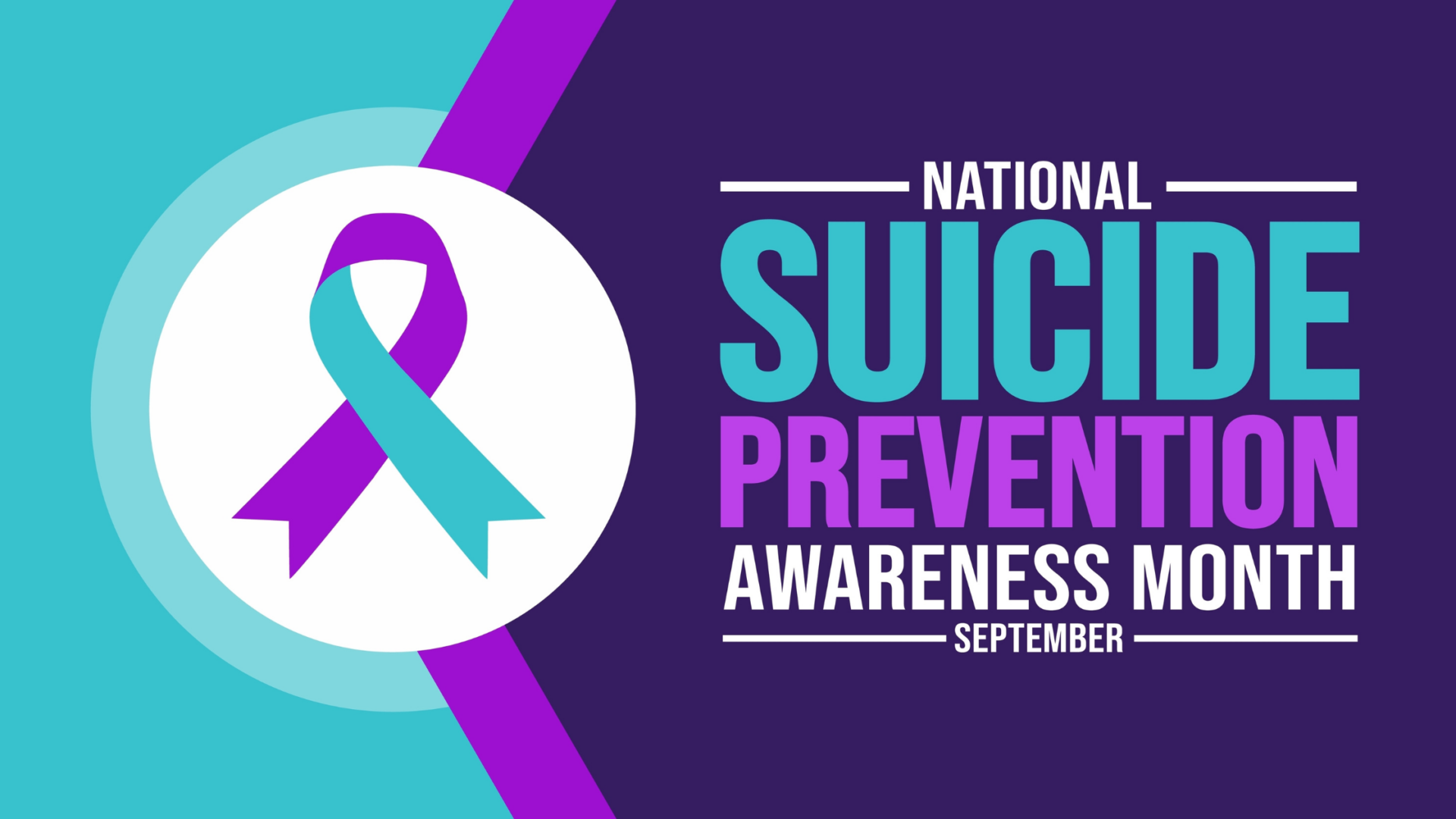September is Suicide Awareness Month
13 September, 2024

September is Suicide Prevention Month, a time dedicated to raising awareness about a complex and often stigmatized issue: suicidal thoughts. It is a month to remember the lives lost to suicide, to support those who struggle with suicidal ideation, and to advocate for a future where mental health is valued, resources are accessible, and help is readily available for those in need.
Beyond the Statistics: A Deeper Understanding
Suicidal thoughts are not a sign of weakness, nor are they a personal failing. They are a symptom of deep distress, often rooted in underlying mental health conditions, traumatic experiences, or challenging life circumstances. While it’s important to recognize the statistical reality of suicide, it’s crucial to look beyond the numbers and understand the human stories behind them. Each life lost to suicide is a tragedy, leaving a void in families, communities, and the world at large.
The World Health Organization reports that approximately 800,000 people die by suicide every year, making it a leading cause of death globally. These statistics represent a tragic reality, particularly amongst young people, where suicide is the second leading cause of death for those aged 15-29. However, these figures only tell a portion of the story. They fail to capture the depth of suffering, the feeling of hopelessness, and the desperate search for relief that often precede a suicide attempt.
The Weight of Stigma: A Barrier to Help
One of the most significant barriers to seeking help for suicidal thoughts is the pervasive stigma surrounding mental health. The fear of judgment, the shame of being seen as weak or broken, and the societal pressure to appear strong and successful often prevent individuals from reaching out for support. This silence can be devastating, isolating those who are struggling and exacerbating their pain.
Breaking the stigma surrounding mental health is crucial to addressing suicide prevention. We must create a society where seeking help is seen as a sign of strength, not weakness, and where open and honest conversations about mental health are encouraged.
Recognizing the Warning Signs: A Call to Action
While the complexities of suicidal ideation make it difficult to pinpoint definitive warning signs, there are certain behaviors and expressions that can indicate a person is in distress and requires immediate attention. These warning signs can manifest in various ways, making it critical to be attentive and observant.
Verbal Cues:
- Talking about death or suicide: Direct statements about wanting to die, feeling hopeless, or being a burden to others.
- Expressing feelings of worthlessness or hopelessness: Feeling like there is no way out of their problems or that life has no meaning.
- Sharing suicidal plans: Describing specific methods or intentions for ending their life.
Behavioral Changes:
- Withdrawal from social activities: Avoiding friends, family, or social events, isolating themselves from others.
- Neglecting personal hygiene: Lack of interest in grooming, cleanliness, or personal appearance.
- Changes in sleep patterns: Sleeping too much, too little, or experiencing difficulty falling asleep.
- Changes in eating habits: Loss of appetite, significant weight loss, or overeating.
- Increased substance abuse: Turning to alcohol or drugs to cope with emotional pain.
- Reckless behavior: Engaging in risky behaviors such as driving recklessly, engaging in dangerous activities, or making impulsive decisions.
- Giving away belongings: Distributing personal possessions as if preparing for death.
Emotional and Mental Changes:
- Increased anxiety and agitation: Feeling restless, jittery, or unable to relax.
- Difficulty concentrating: Struggling to focus, make decisions, or remember things.
- Mood swings: Experiencing extreme emotional highs and lows, unpredictable shifts in mood.
- Loss of interest in activities: Feeling detached and apathetic, lacking enthusiasm for hobbies or interests.
Responding to Warning Signs: Reaching Out and Offering Support
If you notice any of these warning signs in someone you care about, it’s essential to act quickly and with compassion. Don’t hesitate to initiate a conversation, even if you feel uncomfortable or unsure. Your concern and willingness to listen can make a world of difference.
How to Approach the Conversation:
- Express your concern: Let them know you’ve noticed changes in their behavior and that you’re worried about them.
- Ask directly: Don’t be afraid to ask if they are thinking about suicide. This direct approach can often help break down barriers and encourage them to talk openly.
- Listen attentively: Create a safe and non-judgmental space for them to share their thoughts and feelings. Validate their emotions and acknowledge their pain.
- Don’t dismiss their feelings: Avoid minimizing their struggles or suggesting they are simply “overreacting.”
- Offer hope and support: Let them know that there is help available and that things can get better.
- Connect them to resources: Encourage them to reach out to a mental health professional, crisis hotline, or a trusted friend or family member.
Beyond Individual Support: Creating a Culture of Prevention
Addressing suicide requires a multifaceted approach that extends beyond individual support. We need to cultivate a society that fosters mental well-being, promotes early intervention, and supports those struggling with suicidal thoughts. This involves a collective effort from individuals, communities, and institutions.
Investing in Mental Health Resources:
- Expanding access to mental health professionals: Ensuring that everyone has access to affordable and accessible mental health care, regardless of their financial status or geographical location.
- Providing comprehensive training for mental health professionals: Investing in ongoing education and training for mental health professionals to ensure they have the knowledge and skills to effectively address suicidal ideation.
- Investing in research and innovation: Funding research to better understand the causes of suicide, identify effective prevention strategies, and develop new treatment approaches.
Promoting Mental Well-being and Early Intervention:
- Educating communities about suicide prevention: Raising awareness about warning signs, resources, and the importance of seeking help early.
- Promoting mental health literacy: Teaching individuals how to recognize and respond to signs of mental distress in themselves and others.
- Integrating mental health care into primary care: Encouraging routine mental health screenings as part of regular medical checkups.
- Supporting positive mental health: Fostering healthy coping skills, stress management techniques, and promoting self-care practices.
Reducing Access to Lethal Means:
- Implementing safe storage laws for firearms: Requiring secure storage of firearms to prevent accidental suicides or impulsive acts.
- Restricting access to medications and other lethal substances: Implementing safeguards to prevent easy access to medications that can be used for self-harm.
- Developing safer alternatives to lethal methods: Researching and promoting alternative methods of suicide prevention, such as safer bridge design or safer packaging for medications.
Creating a Supportive Environment:
- Building inclusive communities: Fostering a sense of belonging and acceptance for all individuals, regardless of their mental health status.
- Reducing stigma through open communication: Encouraging open dialogue about mental health issues, challenging harmful stereotypes, and promoting empathy and understanding.
- Providing support systems and social safety nets: Ensuring that vulnerable individuals have access to resources and support networks that can help them through difficult times.
Hope for the Future:
Addressing suicide is a complex and multifaceted challenge, but it is not an insurmountable one. Through increased awareness, open communication, and a collective commitment to prevention, we can make a difference in reducing suicide rates and saving lives.
Remember, suicide is preventable, and every life is valuable. By fostering a culture of compassion, understanding, and support, we can create a future where everyone feels empowered to seek help, to reach out for support, and to build a life filled with hope and resilience.
Resources:
- National Suicide Prevention Lifeline: 988
- Crisis Text Line: Text HOME to 741741
- OCFL: https://orange.floridahealth.gov/programs-and-services/violence-and-injury-prevention/suicide-prevention-and-mental-health.html
- OCPS: https://www.ocps.net/departments/student_services/guidance
- The Jed Foundation: https://www.jedfoundation.org/
- American Foundation for Suicide Prevention: https://afsp.org/
- The Trevor Project: https://www.thetrevorproject.org/
Let’s work together to break the silence surrounding suicide and build a future where everyone feels supported, empowered, and hopeful.


